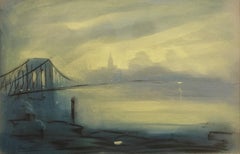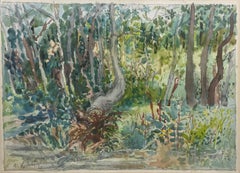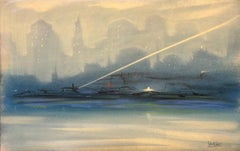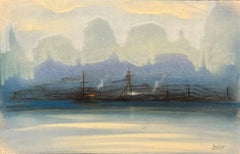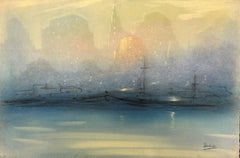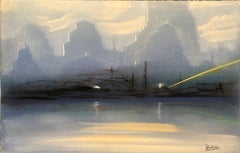Lincoln Glenn Landscape Drawings and Watercolors
to
12
12
13
5
1
1
Overall Width
to
Overall Height
to
4
28
1
1
1
13
1
1
2
2
1
19
4
3
1
24
7
1
12
10
9
8
6
4
3
3
3
3
2
2
2
2
2
2
2
1
1
1
31
16
16
14
12
11
2
2
1
1
20
10
32
"New York Harbor (Brooklyn Bridge)" Leon Dolice, Mid-Century New York Nocturne
By Leon Dolice
Located in New York, NY
Leon Dolice
New York Harbor (Brooklyn Bridge), circa 1939-1940
Signed lower left
Pastel on paper
12 x 19 inches
Exhibited
Roslyn Harbor, New York, Nassau County Museum of Art, Deco ...
Category
1930s American Modern Figurative Drawings and Watercolors
Materials
Paper, Pastel
"Tree at the Edge of the Field, Springs" Nell Blaine, 1967 Abstracted Landscape
By Nell Blaine
Located in New York, NY
Nell Blaine
Tree at the Edge of the Field, Springs, 1967
Signed and dated lower left
Watercolor on paper
14 1/2 x 20 inches
Nell Blaine was born in Richmond, Virginia in 1922. She ...
Category
1960s Modern Figurative Drawings and Watercolors
Materials
Paper, Watercolor
"New York Harbor Nocturne" Leon Dolice, Mid-Century New York Nocturnal Landscape
By Leon Dolice
Located in New York, NY
Leon Dolice
New York Harbor Nocturne
Signed lower right
Pastel on paper
12 x 19 inches
The romantic backdrop of Vienna at the turn of the century had a life-long influence upon the...
Category
1930s American Modern Figurative Drawings and Watercolors
Materials
Paper, Pastel
"New York Harbor Nocturne" Leon Dolice, Mid-Century New York Nocturnal Landscape
By Leon Dolice
Located in New York, NY
Leon Dolice
New York Harbor Nocturne, circa 1930-40
Signed lower right
Pastel on paper
12 x 19 inches
The romantic backdrop of Vienna at the turn of the century had a life-long inf...
Category
1930s American Modern Figurative Drawings and Watercolors
Materials
Paper, Pastel
"New York Harbor Nocturne" Leon Dolice, Mid-Century New York Nocturnal Landscape
By Leon Dolice
Located in New York, NY
Leon Dolice
New York Harbor Nocturne
Signed lower right
Pastel on paper
12 x 19 inches
The romantic backdrop of Vienna at the turn of the century had a life-long influence upon the...
Category
1930s American Modern Landscape Drawings and Watercolors
Materials
Paper, Pastel
"New York Harbor Nocturne" Leon Dolice, Mid-Century New York Nocturnal Landscape
By Leon Dolice
Located in New York, NY
Leon Dolice
New York Harbor Nocturne
Signed lower right
Pastel on paper
12 x 19 inches
The romantic backdrop of Vienna at the turn of the century had a life-long influence upon the...
Category
1930s American Modern Figurative Drawings and Watercolors
Materials
Paper, Pastel
"New York Harbor Nocturne" Leon Dolice, Mid-Century New York Nocturnal Landscape
By Leon Dolice
Located in New York, NY
Leon Dolice
New York Harbor Nocturne
Signed lower right
Pastel on paper
12 x 19 inches
The romantic backdrop of Vienna at the turn of the century had a life-long influence upon the...
Category
1930s American Modern Figurative Drawings and Watercolors
Materials
Paper, Pastel
"New York Harbor Nocturne" Leon Dolice, New York Scene, Mid-Century Landscape
By Leon Dolice
Located in New York, NY
Leon Dolice
New York Harbor Nocturne
Signed lower right
Pastel on paper
12 x 19 inches
The romantic backdrop of Vienna at the turn of the century had a life-long influence upon the...
Category
1930s Figurative Drawings and Watercolors
Materials
Paper, Pastel
"New York Harbor Nocturne" Leon Dolice, New York Harbor Scene Mid-Century
By Leon Dolice
Located in New York, NY
Leon Dolice
New York Harbor Nocturne
Signed lower right
Pastel on paper
12 x 19 inches
The romantic backdrop of Vienna at the turn of the century had a life-long influence upon the...
Category
1930s American Modern Figurative Drawings and Watercolors
Materials
Paper, Pastel
"Empire State Building" Leon Dolice, New York City Street Scene, Mid-Century
By Leon Dolice
Located in New York, NY
Leon Dolice
Empire State Building
Signed lower right
Watercolor on paper
19 x 12 inches
The romantic backdrop of Vienna at the turn of the century had a life-long influence upon th...
Category
1930s American Modern Figurative Drawings and Watercolors
Materials
Paper, Pastel
"Central Park" Leon Dolice, New York Central Park Scene, Mid-Century
By Leon Dolice
Located in New York, NY
Leon Dolice
Central Park
Signed lower left
Watercolor on paper
12 x 19 inches
The romantic backdrop of Vienna at the turn of the century had a life-long influence upon the young ma...
Category
1930s American Modern Figurative Drawings and Watercolors
Materials
Paper, Pastel
$2,400 Sale Price
20% Off
"Chrysler Building" Leon Dolice, New York City Street Scene, Mid-Century
By Leon Dolice
Located in New York, NY
Leon Dolice
Chrysler Building
Signed lower right
Watercolor on paper
19 x 12 inches
The romantic backdrop of Vienna at the turn of the century had a life-long influence upon the yo...
Category
1930s American Modern Figurative Drawings and Watercolors
Materials
Pastel, Paper
"Suburb of Gif-sur-Yvette, France" Henry Yuzuru Sugimoto, Modernist Landscape
Located in New York, NY
Henry Yuzuru Sugimoto
Suburb of Gif-sur-Yvette, France, circa 1928-32
Signed lower left
Watercolor on paper
11 x 14 inches
Henry Sugimoto was born in Wakayama, Japan, on March 12, 1900. His father left for the United States shortly after he was born, and his mother joined him some years later, with the result that the young Henry was raised largely by his grandparents. Following the end of World War I, Henry Sugimoto arrived in the United States as a "yobiyose" (child brought over) and settled with his parents in Hanford, California. After attending Hanford High School, he enrolled at the University of California, Berkeley. He soon grew absorbed in art and his parents agreed to let him enroll at the California School of Arts and Crafts. After studying there for four years with a concentration in oil painting, he graduated with honors in 1928. He then moved to the California School for Fine Arts, but after a year there he decided to travel to France, the international artistic capital, for further study. Once arrived in Paris, Sugimoto became close to the circle of Japanese...
Category
1930s Modern Figurative Drawings and Watercolors
Materials
Paper, Watercolor
"Tugboat at Dock" Reginald Marsh, Modern WPA Industrial Ship, New York Docks
By Reginald Marsh
Located in New York, NY
Reginald Marsh
Tugboat at Dock, circa 1937
Signed lower right
Watercolor and pencil on paper
13 3/4 x 20 inches
Housed in a Lowy frame.
Provenance:
Sotheby'...
Category
1930s Modern Landscape Paintings
Materials
Paper, Watercolor, Pencil
"East Providence" Oscar Bluemner, Drawing of East Providence, Architectural
By Oscar Bluemner
Located in New York, NY
Oscar Bluemner
East Providence, December 21st, 1926
Inscribed with location and dated, upper left "East Providence Dec 21-26"
Black crayon on paper
5 x 7 7/8 inches
Julius Oskar Bl...
Category
Early 20th Century Modern Landscape Drawings and Watercolors
Materials
Crayon
"Beach Scene at Dieppe" James Abbott McNeill Whistler, Tonalist Watercolor
By James Abbott McNeill Whistler
Located in New York, NY
James Abbott McNeill Whistler
Beach Scene at Dieppe, 1885-86
Watercolor on paper, mounted on board
8 1/2 x 5 inches
Signed on the reverse
Provenance:
Miss Annie Burr Jennings
Mrs. ...
Category
1880s Impressionist Landscape Drawings and Watercolors
Materials
Paper, Watercolor
"Sheepshead, Brooklyn, Long Island" Oscar Bluemner, Modernist Watercolor
By Oscar Bluemner
Located in New York, NY
Oscar Bluemner
Sheepshead, Long Island, 1907
Signed with the artist's conjoined initials "OB" and dated "4-30 - 5 - 30" / "Aug 3, 07"
Watercolor on paper
6 x 10 inches
Provenance:
J...
Category
Early 1900s American Modern Landscape Drawings and Watercolors
Materials
Paper, Watercolor
"Untitled I" Jane Freilicher, Hamptons Landscape Drawing, Mid-century Abstract
By Jane Freilicher
Located in New York, NY
Jane Freilicher
Untitled I, 1958-59
Signed lower right
Charcoal on paper
11 1/2 x 8 3/4 inches
Provenance:
Tibor de Nagy Gallery, New York
Private Collection, New York
Jane Freilic...
Category
1950s Modern Landscape Drawings and Watercolors
Materials
Paper, Charcoal
"Gray Morning" James MacMaster, Scottish Seascape, Marine Ship Landscape
By James MacMaster
Located in New York, NY
James MacMaster
Gray Morning
Signed and titled lower left
Watercolor on paper
10 1/4 x 14 inches
Provenance:
Private Collection, New Jersey
Category
Late 19th Century Landscape Paintings
Materials
Paper, Watercolor
$540 Sale Price
70% Off
"New York City Skyline View from the East River, " Lionel Reiss, Jewish Artist
By Lionel Reiss
Located in New York, NY
Lionel S. Reiss (1894 - 1988)
New York City Skyline View from the East River
Watercolor on paper
13 x 19 inches
Signed lower left
In describing his own style, Lionel Reiss wrote, “By nature, inclination, and training, I have long since recognized the fact that...I belong to the category of those who can only gladly affirm the reality of the world I live in.” Reiss’s subject matter was wide-ranging, including gritty New York scenes, landscapes of bucolic Bucks County, Pennsylvania, and seascapes around Gloucester, Massachusetts. However, it was as a painter of Jewish life—both in Israel and in Europe before World War II—that Reiss excelled. I.B. Singer, the Nobel Prize winner for Literature, noted that Reiss was “essentially an artist of the nineteenth century, and because of this he had the power and the courage to tell visually the story of a people.”
Although Reiss was born in Jaroslaw, Poland, his family immigrated to the United States in 1898 when he was four years old. Reiss's family settled on New York City’s Lower East Side and he lived in the city for most of his life. Reiss attended the Art Students League and then worked as a commercial artist for newspapers and publishers. As art director for Metro-Goldwyn-Mayer, he supposedly created the studio’s famous lion logo.
After World War I, Reiss became fascinated with Jewish life in the ‘Old World.’ In 1921 he left his advertising work and spent the next ten years traveling in Europe, the Middle East, and North Africa. Like noted Jewish photographers Alter Kacyzne and Roman Vishniac, Reiss depicted Jewish life in Poland prior to World War II. He later wrote, “My trip encompassed three main objectives: to make ethnic studies of Jewish types wherever I traveled; to paint and draw Jewish life, as I saw it and felt it, in all aspects; and to round out my work in Israel.”
In Europe, Reiss recorded quotidian scenes in a variety of media and different settings such as Paris, Amsterdam, the Venice ghetto, the Jewish cemetery in Prague, and an array of shops, synagogues, streets, and marketplaces in the Jewish quarters of Warsaw, Lodz, Krakow, Lublin, Vilna, Ternopil, and Kovno. He paid great attention to details of dress, hair, and facial features, and his work became noted for its descriptive quality.
A selection of Reiss’s portraits appeared in 1938 in his book My Models Were Jews. In this book, published on the eve of the Holocaust, Reiss argued that there was “no such thing as a ‘Jewish race’.” Instead, he claimed that the Jewish people were a cultural group with a great deal of diversity within and between Jewish communities around the world. Franz Boas...
Category
1940s American Modern Landscape Drawings and Watercolors
Materials
Paper, Watercolor
$2,800 Sale Price
20% Off
"Andes Mountains Peru South America, " Joseph Yoakum, Black Folk Art Landscape
By Joseph Yoakum
Located in New York, NY
Joseph Yoakum
Andes Mountains Peru So America, circa 1960s
Colored pencil and ballpoint pen on paper
7 1/4 x 10 1/2 inches
Provenance:
Karen Lennox Gallery, Chicago
Private Collection, South Dakota
Yoakum began drawing in the early 1960s. Most of his work consists of radiantly colored landscapes with mountains, water, trees, and winding roads in abstract and complex configurations. his period of greatest activity — 1965 to 1970 — when he usually made one drawing a day.
Yoakum maintained he had seen all the places represented in his drawings, a statement that may not be true in some instances. He traveled a great deal, beginning in his early teens when he ran away from home and became a circus handyman. Yoakum’s drawings can be considered memory images growing out of either actual or imagined experiences. All of his drawings have titles that grew longer and more specific over the years. He dated his works with a rubber stamp — an oddly impersonal, labor-saving device.
Although Joseph Yoakum gave vastly different accounts of his background, he was, throughout his life, classified as an African American. Sometimes Yoakum claimed that he was a full-blooded “Nava-joe” Indian, one of twelve or thirteen children born to a farmer on an Indian reservation in Window Rock, Arizona. At other times he insisted that he was of African-American descent. He described his mother as a strong woman who was a doctor and knowledgeable in the use of herbal medicines. Yoakum’s family moved to Kansas City, Missouri, during his early childhood. His father was employed briefly in the railroad yards prior to settling permanently on a farm in nearby Walnut Grove...
Category
1960s Folk Art Landscape Paintings
Materials
Paper, Watercolor, Ballpoint Pen, Color Pencil
"Gloucester Harbor at Sunset, " John Hare, Cape Ann, New England Watercolor View
Located in New York, NY
John Hare
Gloucester Harbor at Sunset, Massachusetts
Signed lower right
Watercolor on paper
16 x 12 inches
John Cuthbert Hare, 1908-1978, was a watercolorist who painted boats, seascapes and harbor scenes. He was primarily associated New England, especially Cape Cod, Massachusetts where he spent his summers from 1938 to 1965. However, he was in Florida where he was a member of the St. Augustine Art Association, and other locations on the East Coast.
It is likely Hare was born in New York City. He first studied commercial art in Brooklyn at the Pratt Institute and also studied at the Art Students League in Manhattan. He worked for Hearst newspapers corporation, and in 1933 married. In the next few years, he and his wife traveled extensively, camping and painting and exhibiting his work in galleries.
In 1935, they visited St. Augustine and an exhibition of his watercolors was held there in the old bank...
Category
Mid-20th Century Impressionist Landscape Drawings and Watercolors
Materials
Paper, Watercolor
"Gondolas at the Dock, Venice, Italy" Louis Wolchonok, Boats in the Harbor Scene
By Louis Wolchonok
Located in New York, NY
Louis Wolchonok (1898 - 1973)
Gondolas at the Dock, Venice, Italy, 1928
Watercolor on paper
Sight 18 x 23 1/2 inches
Signed and dated lower right
Louis Wolchonok was an author of ar...
Category
1920s Post-Impressionist Landscape Drawings and Watercolors
Materials
Paper, Watercolor
Out of the Sun (Under the Racetrack Grandstand), Saratoga Springs, Anne Diggory
By Anne Diggory
Located in New York, NY
Anne Diggory (b. 1951)
Out of the Sun (Under the Racetrack Grandstand), 1978
Watercolor on paper
7 x 10 inches
Signed and dated lower left
Provenance:
Ac...
Category
1970s Contemporary Landscape Drawings and Watercolors
Materials
Paper, Watercolor, Pencil
"Train Station, " Max Kuehne, Industrial City Scene, American Impressionism
By Max Kuehne
Located in New York, NY
Max Kuehne (1880 - 1968)
Train Station, circa 1910
Watercolor on paper
8 1/4 x 10 1/4 inches
Signed lower right
Provenance:
Private Collection, Illinois
Max Kuehne was born in Halle, Germany on November 7, 1880. During his adolescence the family immigrated to America and settled in Flushing, New York. As a young man, Max was active in rowing events, bicycle racing, swimming and sailing. After experimenting with various occupations, Kuehne decided to study art, which led him to William Merritt Chase's famous school in New York; he was trained by Chase himself, then by Kenneth Hayes Miller. Chase was at the peak of his career, and his portraits were especially in demand. Kuehne would have profited from Chase's invaluable lessons in technique, as well as his inspirational personality. Miller, only four years older than Kuehne, was another of the many artists to benefit from Chase's teachings. Even though Miller still would have been under the spell of Chase upon Kuehne's arrival, he was already experimenting with an aestheticism that went beyond Chase's realism and virtuosity of the brush. Later Miller developed a style dependent upon volumetric figures that recall Italian Renaissance prototypes.
Kuehne moved from Miller to Robert Henri in 1909. Rockwell Kent, who also studied under Chase, Miller, and Henri, expressed what he felt were their respective contributions: "As Chase had taught us to use our eyes, and Henri to enlist our hearts, Miller called on us to use our heads." (Rockwell Kent, It's Me O Lord: The Autobiography of Rockwell Kent. New York: Dodd, Mead and Co., 1955, p. 83). Henri prompted Kuehne to search out the unvarnished realities of urban living; a notable portion of Henri's stylistic formula was incorporated into his work.
Having received such a thorough foundation in art, Kuehne spent a year in Europe's major art museums to study techniques of the old masters. His son Richard named Ernest Lawson as one of Max Kuehne's European traveling companions. In 1911 Kuehne moved to New York where he maintained a studio and painted everyday scenes around him, using the rather Manet-like, dark palette of Henri.
A trip to Gloucester during the following summer engendered a brighter palette. In the words of Gallatin (1924, p. 60), during that summer Kuehne "executed some of his most successful pictures, paintings full of sunlight . . . revealing the fact that he was becoming a colorist of considerable distinction." Kuehne was away in England the year of the Armory Show (1913), where he worked on powerful, painterly seascapes on the rocky shores of Cornwall. Possibly inspired by Henri - who had discovered Madrid in 1900 then took classes there in 1906, 1908 and 1912 - Kuehne visited Spain in 1914; in all, he would spend three years there, maintaining a studio in Granada. He developed his own impressionism and a greater simplicity while in Spain, under the influence of the brilliant Mediterranean light. George Bellows convinced Kuehne to spend the summer of 1919 in Rockport, Maine (near Camden). The influence of Bellows was more than casual; he would have intensified Kuehne's commitment to paint life "in the raw" around him.
After another brief trip to Spain in 1920, Kuehne went to the other Rockport (Cape Ann, Massachusetts) where he was accepted as a member of the vigorous art colony, spearheaded by Aldro T. Hibbard. Rockport's picturesque ambiance fulfilled the needs of an artist-sailor: as a writer in the Gloucester Daily Times explained, "Max Kuehne came to Rockport to paint, but he stayed to sail." The 1920s was a boom decade for Cape Ann, as it was for the rest of the nation. Kuehne's studio in Rockport was formerly occupied by Jonas Lie.
Kuehne spent the summer of 1923 in Paris, where in July, André Breton started a brawl as the curtain went up on a play by his rival Tristan Tzara; the event signified the demise of the Dada movement. Kuehne could not relate to this avant-garde art but was apparently influenced by more traditional painters — the Fauves, Nabis, and painters such as Bonnard. Gallatin perceived a looser handling and more brilliant color in the pictures Kuehne brought back to the States in the fall. In 1926, Kuehne won the First Honorable Mention at the Carnegie Institute, and he re-exhibited there, for example, in 1937 (Before the Wind). Besides painting, Kuehne did sculpture, decorative screens, and furniture work with carved and gilded molding. In addition, he designed and carved his own frames, and John Taylor Adams encouraged Kuehne to execute etchings. Through his talents in all these media he was able to survive the Depression, and during the 1940s and 1950s these activities almost eclipsed his easel painting. In later years, Kuehne's landscapes and still-lifes show the influence of Cézanne and Bonnard, and his style changed radically.
Max Kuehne died in 1968. He exhibited his work at the National Academy of Design, the Art Institute of Chicago, the Carnegie Institute in Pittsburgh, the Memorial Art Gallery of the University of Rochester, and in various New York City galleries. Kuehne's works are in the following public collections: the Detroit Institute of Arts (Marine Headland), the Whitney Museum (Diamond Hill...
Category
1910s American Impressionist Landscape Drawings and Watercolors
Materials
Paper, Watercolor
"Hydrangeas, " Walter Inglis Anderson, Mississippi Southern Illustrator, Flowers
Located in New York, NY
Walter Anderson ( American, 1903 - 1965)
Hydrangeas, circa 1950
Mixed media on paper
11 x 8 1/2 inches
Provenance:
Luise Ross Gallery, New York
Private Collection, New Jersey
Acquired from the estate of the above, 2021
Walter Anderson firmly believed that quality art was an important part of life and should be made available to everyone. As he said, "There should be simple, good decorations, to be sold at prices to rival the five-and-ten." Noticing that only poor quality art was available in stores and little was available for children, he resolved to make art which could be reproduced easily and sell inexpensively — linoleum block prints. This technique enabled him to provide affordable, quality art.
The technique of linoleum block printing is a simple concept; however, it requires much skill and talent to actually produce memorable art. Anderson purchased surplus "battleship linoleum," thicker than ordinary linoleum with a burlap backing for better support, to create his blocks. During the mid-1940s, he created almost 300 linocuts working in the attic of the sea-side plantation house, Oldfields, his wife's family home in Gautier. Masses of linoleum chips accumulated at the foot of the attic stairs as he often worked night and day. He began with sketching out a design directly on the linoleum. Once he had carved the image into the surface, he used the back of faded, surplus stock wallpaper that a friend sent him, laying long strips on top of the inked linoleum. A roller made of sewer pipe filled with sand served as his press. When the print was completed, he often colored it by hand with bold strokes and vivid colors. The prints were sold at Shearwater Pottery, the family business, for a mere dollar a foot.
But "what about a well-designed fairy tale for a child's room?" he asked himself. Since there was a lack of affordable art for children, much of his work with linoleum blocks focused on subjects for children. He depicted fables and fairy tales ranging from Arabian Nights, to Germany and the Grimm Brothers' Rapunzel, to the French story of The White Cat, to the Greek tales such as Europa and the Bull, and to tales from China, India, and other cultures. Anderson also created "mini" books featuring the alphabet and Robinson Cat. The blocks are not only alive with the story being depicted, but they are also filled with designs taken from Best-Maugard's Method for Creative Design. Swirls, half-circles and zig-zag lines fill every available space on the linoleum block making them come alive and capture their audience.
But fairy tales, children's verses and the "mini" books, consisting of about 90 blocks, were not the sole subject of Anderson's linoleum block prints. In total, he created approximately 300 linoleum blocks with subjects ranging from coastal flora and fauna, coastal animals, and sports and other coastal activities. Anderson even created linoleum blocks to be used to print tablecloths and clothing, some worn by his own children. Color and subjects of the linoleum block prints were not the only things that got them noticed.
In 1945 when Anderson was creating these prints, the standard size of linoleum block prints was only 12 by 18 inches. These small dimensions were due to the common size of the paper available and the restrictions made by national competitions. Since Anderson used wallpaper...
Category
Mid-20th Century American Modern Landscape Paintings
Materials
Paper, Crayon
"Monhegan Island, Maine, " Edward Dufner, American Impressionism Landscape View
By Edward Dufner
Located in New York, NY
Edward Dufner (1872 - 1957)
Monhegan Island, Maine
Watercolor on paper
Sight 16 x 20 inches
Signed lower right
With a long-time career as an art teacher and painter of both 'light' and 'dark', Edward Dufner was one of the first students of the Buffalo Fine Arts Academy to earn an Albright Scholarship to study painting in New York. In Buffalo, he had exchanged odd job work for drawing lessons from architect Charles Sumner. He also earned money as an illustrator of a German-language newspaper, and in 1890 took lessons from George Bridgman at the Buffalo Fine Arts Academy.
In 1893, using his scholarship, Dufner moved to Manhattan and enrolled at the Art Students League where he studied with Henry Siddons Mowbray, figure painter and muralist. He also did illustration work for Life, Harper's and Scribner's magazines.
Five years later, in 1898, Dufner went to Paris where he studied at the Academy Julian with Jean-Paul Laurens and privately with James McNeill Whistler. Verification of this relationship, which has been debated by art scholars, comes from researcher Nancy Turk who located at the Smithsonian Institution two 1927 interviews given by Dufner. Turk wrote that Dufner "talks in detail about Whistler, about how he prepared his canvasas and about numerous pieces he painted. . . A great read, the interview puts to bed" the ongoing confusion about whether or not he studied with Whistler.
During his time in France, Dufner summered in the south at Le Pouleu with artists Richard Emil Miller...
Category
Early 20th Century American Impressionist Landscape Drawings and Waterco...
Materials
Paper, Watercolor
"Saratoga, " John Francis Murphy, Hudson River School, Tonalism
By John Francis Murphy
Located in New York, NY
John Francis Murphy (1853 - 1921)
Saratoga, 1876
Graphite on paper
Sight 8 3/4 x 10 1/2 inches
Titled and dated to lower right
Provenance:
Babcock Galleries, New York
Spanierman Gallery, New York
In his lifetime, John Francis Murphy (1853-1921) was known as “the American Corot.” He was renowned for his small, intimate views of nature, especially barren fields and farms, bare trees, and lonely marshland. More than a century later, the power of Murphy’s landscapes has not waned. One contemporary critic wrote, “It was Murphy’s unique accomplishment to achieve an absolute realism without a loss of that mystic, indefinable quality which transfigures realism.”
John Francis Murphy was born at Oswego, NY in 1853 but his family moved to Chicago in 1868 where he worked painting theater sets. Murphy was basically a self-taught artist; his only formal training was a few weeks of instruction at the Chicago Academy of Design.
In 1875, Murphy moved from Chicago to New York, eventually rooming with the painters Dennis Bunker and Bruce Crane above a bakery shop. Murphy’s early work was typical of the Hudson River school but he soon fell under the sway of the loose brushwork and moody style of French Barbizon painting...
Category
1870s Tonalist Landscape Drawings and Watercolors
Materials
Paper, Pencil
$2,800 Sale Price
20% Off
"Medieval Thoughts, Prague, " Alphonse Mucha, Czech Art Nouveau Illustration
By Alphonse Mucha
Located in New York, NY
Alphonse Mucha (Czech, 1860 - 1939)
Medieval Thoughts, circa 1890
Wash, ink, and watercolor on paper
11 x 9 inches
Signed lower right
Provenance:
Phillips New York, 19th and 20th ce...
Category
1890s Art Nouveau Figurative Drawings and Watercolors
Materials
Paper, Ink, Watercolor
"Tokyo Diptych" Yvonne Jacquette, Japanese Urban Cityscape Nocturnal Aerial
By Yvonne Jacquette
Located in New York, NY
Yvonne Jacquette (American, b. 1935)
Tokyo Diptych, 1985
Pastel on paper
Overall 17 1/4 x 28 1/2 inches
Signed lower center
Provenance:
Carey Ellis Company, Houston, Texas
Brooke Alexander, New York
Collection of an American Corporation
Exhibited:
New York, Brooke Alexander, Yvonne Jacquette: Tokyo Nightviews, April 5 - May 3, 1986, n.p., illustrated; this exhibition later traveled to Brunswick, Maine, Bowdoin College Museum of Art, Yvonne Jacquette: Tokyo Nightviews, June 27 - August 24, 1986.
Yvonne Jacquette has a preference for high places, a circling plane, a penthouse window, an aerie from which to watch the world. Her work has often depicted the city and man-made landscape from the vantage of angels. It is a privileged perspective, long loved by photographers, who were perhaps the first to recognize the geometric grandeur of the city below. That grandeur structures Jacquette's images but is not its full content. Her work attempts to resolve the visual and emotional pardoxes of the modern metropolis. Only from the tower is there the possibility of order and context. And unlaced beauty.
Jacquette first visited Japan in 1982. Nighttime Tokyo, its cars and crowds and canyons of loud Vegas neon, made a vivid and bewildering impression on her. The neon signs, pulsing, scaling the walls of high rises, fascinated the artist, "like Times Square spread over miles." Her fascination was equal parts marvel, confusion, and curiosity—the sparks of art. She returned to Tokyo in May of 1985, choosing hotel rooms with expansive vistas. From these views Jacquette excerpted images for a series of pastel night scenes. The basic forms and colors of each drawing were blocked in during night sessions by the window. She worked in the dark, selecting colors by flashlight. In daylight, she sharpened the geometry and corrected ambiguous passages. She refined the drawings further in the studio until the images read clearly. Photographic correctness was not important. The finished drawings are complete statements, not simply preparatory sketches for paintings. They have the authority of expert witness. In clear, discreet jots of pastel they record the performance of seeing, each touch of color attesting to a moment's close scrutiny.
Yvonne Jacquette was born on December 15, 1934 in Pittsburgh, Pennsylvania and grew up in Stamford, Connecticut. She attended the Rhode Island School of Design, Providence from 1952 to 1955, when she moved to New York City. Her late husband was photographer Rudy Burckhardt, and the couple were part of a circle of artist friends that included Fairfield Porter, Alex Katz, Red Grooms, and Mimi Gross. She continues to live and work in New York City, as well as in Searsmont, Maine.
A flight to San Diego in 1969 sparked Jacquette’s interest in aerial views, after which she began flying in commercial airliners to study cloud formations and weather patterns. She soon started sketching and painting the landscape as seen from above, beginning a process that has developed into a defining element of her art. Her first nocturnal painting...
Category
1980s American Modern Landscape Drawings and Watercolors
Materials
Paper, Pastel
Five at the Rail, View of Racetrack and Crowd, Saratoga Springs, New York
By Anne Diggory
Located in New York, NY
Anne Diggory (b. 1951)
Five at the Rail, Saratoga Springs Racecourse, New York, circa 1978
Watercolor on paper
4 3/4 x 6 inches
Initialed lower right: Dig...
Category
1970s Contemporary Landscape Drawings and Watercolors
Materials
Paper, Watercolor
"New England Landscape, " James Grabowski, View of Connecticut Hills in the Sun
Located in New York, NY
James L. Grabowski (American born 1944)
New England Landscape
Gouache on paper
27 1/2 x 39 1/2
Signed on the reverse
Has a plaque for Arches Paper Award
James Grabowski...
Category
Late 20th Century Contemporary Landscape Drawings and Watercolors
Materials
Paper, Gouache
